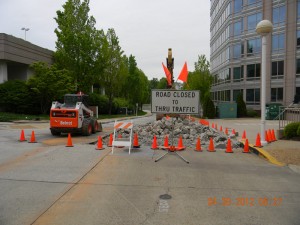Summer is known for heat, heavy unexpected rain storms, and humidity. This generally moist atmosphere means that moisture can seep into the cracks in your concrete pool deck easily. The moisture of the cold winter can be especially damaging to concrete, the freeze thaw cycle leading to all sorts of concrete pool deck cracks and damage which needs to be repaired come spring in time to be enjoyed during the hot summer. It’s best to be as proactive about any concrete pool deck repair as possible. The earlier in the season, the better.
Blog
Posts Tagged ‘Concrete cracking’
Prepare for Summer With Concrete Pool Deck Repair
Thursday, May 26th, 2016Dealing with Concrete Cracking
Friday, January 2nd, 2015 Another new year means your concrete surfaces are another year older. And if your concrete sidewalks, driveways, parking lots, and roadways are starting to show their age, it is important to act fast. As the old saying goes, a stitch in time saves nine. Well, in this instance, dealing with concrete cracks early saves your concrete from premature failure.
Another new year means your concrete surfaces are another year older. And if your concrete sidewalks, driveways, parking lots, and roadways are starting to show their age, it is important to act fast. As the old saying goes, a stitch in time saves nine. Well, in this instance, dealing with concrete cracks early saves your concrete from premature failure.
Dealing with Concrete Cracking
All good things must come to an end. Nothing lasts forever, but if paved correctly and properly maintained, your concrete sidewalks could last 20 to 40 years. But the key phrase here is “properly maintained.” This means dealing with concrete cracking as it happens. Addressing small cracks when they happen is much easier and much more cost-effective than trying to fix larger cracks, which result from neglect. This is especially the case in winter.
When water penetrates concrete cracks in the winter, the water freezes, expands, and widens these cracks. This happens numerous times over the course of a winter, worsening cracks each and every time and degrading your asphalt surface from the inside out.
“Any time you have weather where it is 60 degrees one day and 20 degrees the next, you’re going to have a significant impact on the pavement,” said Rob Morosi, Michigan Department of Transportation spokesman.
This is why concrete cracking needs to be dealt with as it happens.
“Crack sealing and filling are imperative preventative maintenance tools,” sates the Federal Highway Administration Manual of Practice (FWHA Report Number FHWS-RD-99-147). Crack filling helps reduce pavement degradation by restricting water penetration into the underlying bas and sub-base.
Crack Filling and Sealing from PTG Enterprises
Cracking is inevitable. All concrete cracks eventually. How severe that cracking becomes is up to you. When your concrete pavement begins to show signs of wear and tear, you need the help of an expert. You need PTG Enterprises. We are experts when it comes to commercial concrete jobs. Our crews are extremely familiar with all types of concrete paving, so you know the job will look professional and last for years to come.
If you have any questions about Dealing with Concrete Cracking, please contact PTG Enterprises today by calling 410-636-8777, or click here today! You can also check us out on Facebook and Twitter.
Concrete Cracking: Is it time to call your Baltimore Concrete Contractor?
Friday, January 11th, 2013When it comes to your concrete, whether it is a driveway, sidewalk, or parking lot, it will eventually crack. That is just life. Even the best concrete cracks eventually. The key to concrete longevity is to address these cracks as they happen…before they get out of control.
Remember the old adage, “a stitch in time saves nine?” Well, the same holds true for concrete. Addressing a small crack when it happens is much easier and much more cost-effective than trying to fix larger or multiple cracks.

When your concrete pavement begins to show signs of wear and tear, you need the help of an expert. So call the concrete experts at PTG Enterprises before that small crack becomes a major issue. Our crews are the best available and they use only the best materials and equipment around.
Concrete Cracking FAQs
- What Causes Concrete Cracking? Well, there is no one answer. Cracking is typically the result of several factors, including drying shrinkage, thermal contraction, restraint (external or internal) to shortening, subgrade settlement, and applied loads.
- Can Concrete Cracking be prevented? Yes and no. With proper concrete maintenance, concrete longevity can be increased, but eventually all concretes will crack.
- All Concrete Contractors are the same, right? No! Just as in any profession, there are good and bad concrete contractors. And if you choose a bad contractor, your concrete could fail quicker than normal. Improper installation is one of the number one causes of concrete failure.
Do yourself a favor and call PTG Enterprises for all of your concrete needs, both installation and repair. PTG Enterprises are experts with commercial concrete jobs. We work closely with you to ensure the details of the project are fully understood, and that timetables are met.
Our crews are extremely familiar with all types of concrete paving, so you know the job will look professional and last for years to come.
If you have any further questions, please contact PTG Enterprises aka My Pavement Guy today by calling 410-636-8777, or click here today!
How to Identify Pavement Distress
Thursday, June 2nd, 2011Unfortunately, even the best pavement is not indestructible. Heavy traffic usage and weather changes, along with several other outside factors, can lead to pavement distress, which is noticeable physical damage on roads or sidewalks. If not dealt with quickly, pavement distress can lead to more serious problems, all of which can significantly shorten the lifespan of your pavement.
But how can you spot pavement distress in time? This article from eHow.com explains how you can quickly identify pavement distress.
1. Assess cracks on the surface of the pavement. Alligator cracking appears as a network of cracks, forming a pattern somewhat like the skin of an alligator or wonky squares. As the U.S. Department of Transportation outlines in its “Pavement Distress Identification Manual for the NPS Road Inventory Program, 2006 -2009,” the severity of the distress can be measured. It is considered low when the width of the crack is less than 1/4 inch in width. However, the alligator distress is serious when the cracks are more than 3/4 inch wide.
2. Check the pavement’s surface for long strips of cracking. These are ruts that run either along the length of the pavement or sideways across the surface. In places where the cracks are more than 3/4 inch in width, the distress is considered serious and can buckle the pavement, causing bumps. Hot weather can cause this type of pavement distress.
3. Identify gouged-out areas or dips on the surface of the road. Pavement distress is characterised by potholes. These are concave holes on the surface, which are a nuisance for drivers. The holes can cause punctures in tires, gather water and lead to further cracking.
4. Look for dark square or rectangular patches of asphalt on the pavement. Distress can be identified by finding discolored areas where potholes or previous distress marks have been filled or covered over. The replacement asphalt causes a dark patch to be seen. Cracking, ruts or potholes can often be seen in proximity to the patching, which is indicative of pavement distress.
5. Crouch down and look across the surface of the pavement. Identify two lines of depressions in the road’s surface. If these are in the direction of the wheel paths, this distress is called rutting. Rutting occurs when continuous use of the pavement by heavy vehicles causes the surface to sink. It is classified as severe when the depressions are greater than 1 inch below the surface of the pavement.
Once you have identified pavement distress, it is time to repair the damage. There are several products available that allow you to do the job yourself, but if you want to ensure your pavement is properly fixed, it is probably best to call a professional.
If you have any questions or if you would rather leave the repair work to the professionals, contact PTG Enterprises by calling 410-636-8777 or click here


















